No, angelfish cannot live with goldfish. Although angelfish and goldfish have similar characteristics, to the extent that they are both popular freshwater fish, there are marked differences in their characteristics and preferences that make them incompatible as tank mates in a community tank.
This article discusses in detail the reasons angelfish cannot live with goldfish and other important concerns. It promises to help you make informed decisions when choosing a tank mate for either your goldfish or angelfish.
Reasons Angelfish Cannot Live With Goldfish

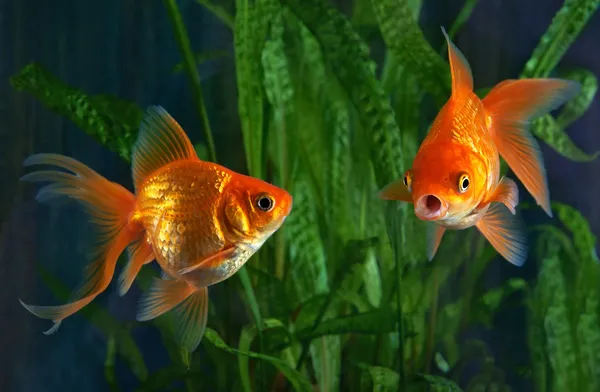
Competition for Food
It would be a bad decision to pair angelfish with goldfish in the same tank. Both fish species are omnivores. This means their diets are pretty much the same, and the consequence is that a species will be malnourished because of the competition for the same foods.
Angelfish and goldfish will happily eat flakes and pellets. They enjoy meaty food choices. They will eat varied food choices featuring high sinking pellets, blood worms, or daphnia. They also love to feast on mosquito larvae and shrimp, whether live or frozen.
As omnivores, they also enjoy chopped vegetables. They also eat marine algae products such as brown seaweed. Other plants they both enjoy include African water ferns, Anubias, Java moss, and other great freshwater plants.
While goldfish tend to be a little less temperamental, angelfish are a highly aggressive species at maturity and feed aggressively.
Competition for food in the tank will lead to fights between both fish breeds. The consequences may include health challenges from underfeeding or malnutrition, most likely for your goldfish. This means that in the long run, you would have sacrificed a species for the other because, as with the rules of nature, one species must go for the other to survive when resources are scarce.
Otherwise, you will have to pay more attention to feeding needs, feed more, and take extra time to always remove the leftovers so that your fish are not put at risk of contaminated water from too much waste.
Why go through all this stress when it would have been more efficient to keep only one species or find a less aggressive tankmate?
Mannerisms
Another reason it would not be ideal to house angelfish with goldfish in the same fish tank is that both these fish species are territorial to varying degrees.
Angelfish usually become very territorial when they become adult fish. You will often see them get into fights with a new fish in the community tank, even if it is a member of their species. They will also become aggressive and territorial towards other fish if there is a sudden change in the water condition.
While aggression is a usual trait for the angelfish, goldfish live peacefully. But they can be territorial in certain select cases.
Sometimes, the territorial nature is often accompanied by aggressive behaviors.
When there are sudden environmental changes in the tank, such as when water parameters have significantly changed, goldfish can become territorial with a favorable spot in the tank if they find the spot as the most comfortable in the tank.
Imagine the damage of having two territorial species in one tank!
Both these fish species are bound to fight for the favorable spots in the tank. So it is not advisable to keep both species in the same tank. The possibility of a confrontation between both is almost impossible.
The Difference in Water Conditions
The difference in aquarium water is another reason. As shocking as it may seem, although Angelfish and goldfish are freshwater fish species, they both have different water requirements to survive.
Angelfish thrive better in slightly acidic but soft water with a hardness of about 3° to 8° DKH. The aquarium ph level for the water in your angelfish tank should be in the range of 6.8 to 7.8. The water temperature should be anywhere from 75°F to 86°F.
They may also keep up with higher water temperatures if the tank is constantly kept clean and healthy and they are supplied with proper food at the right time.
Another thing that can help them tolerate higher temperatures is a regular water change of about 10% every 6-7 days or a 25% change every other week while carrying on with the ideal temperature.
Goldfish, on the contrary, prefer a lower water temperature. They thrive best in water temperatures in the range of 65°F-75°F. They are very hardy fish and can tolerate even colder temperatures.
Interestingly, common goldfish can tolerate temperature falls as low as 40°F. Fancy goldfish may tolerate lower temperatures but prefer 65°F as the lowest. But their ph requirement is almost the same as that of Angelfish; 6.5 to 7.5.
Related: How to Lower pH Levels In Aquariums
Goldfish is a hardy fish species and even the most sturdy tropical water fish species. They can tolerate a wider range of water conditions.
But the water requirements for goldfish and angelfish in terms of temperature only meet somewhat in the middle. While Angelfish like warmer temperatures, goldfish thrive in cold temperatures.
This difference makes it challenging for angelfish to pair as tankmates with goldfish.
The Difference in Aquarium Size
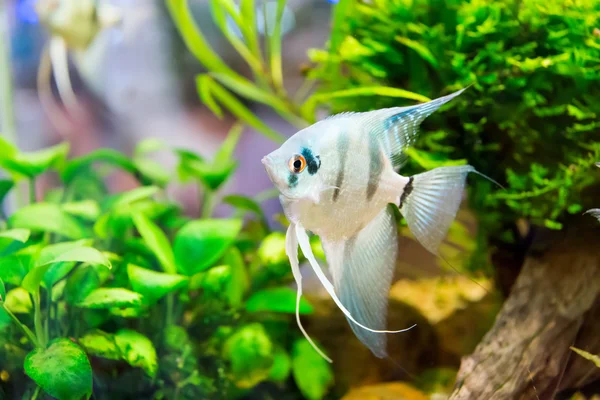
The difference in tank requirements also makes it unwise to pair angelfish with goldfish.
Goldfish need a larger tank for healthy development. They grow big in time, and the availability of space has an impact on their development and overall health. You need about 10 gallons for a goldfish. And you may need to provide more water for an adult goldfish as they can grow up to 12 inches and more with the proper care practice.
Ideally, a tank of about 30-40 gallons of water should do for adult goldfish to reach its maximum length.
On the other hand, angelfish may not need tanks as big as 10 gallons per fish. They require allowable space of about four gallons per fish. That is a whopping 6-gallon difference in tank size requirement!
However, they are agile swimmers and need a lot of space in the aquarium to swim all they like. They also need sufficient space for a sufficient number of hides to hide in the face of threats. This means tank size requirements for angelfish should be based on a holistic view taking into account their agile swimming habits.
The implication is that even a big tank for both fish will be overcrowded.
If you must provide ample space for both fish to cohabit, you will need to provide a tank as big as 30-40 gallons for a goldfish and factor in another 20-30 gallons for the angelfish.
While this may seem possible, it will be grossly inefficient as you would have to buy or fix a bigger filtration system to match the size of the tank and a better temperature measuring equipment to watch the temperature.
You would need tall tanks with a good filtration system, and you’ll have to do aquarium maintenance more often. The challenges of a tank that big would be too much, given the fact that a better tank mate with more similarities will not require all that much expense.
If you keep both fish in the same tank of regular aquarium size, your fish will suffer health complications from the competition for food and the higher rate of pollution. Your angelfish will become stressed from the reduced ample space for swimming.
Can Angelfish Kill Goldfish?
Although aggression is a part of angelfish nature, especially when the fish is under stress, it is rare to find angelfish kill goldfish. But this does not mean they will not kill goldfish.
The best they may do is to bite sharply at the goldfish but eating the goldfish is highly unlikely.
The instance where your angelfish is likely to eat your goldfish is when your goldfish is no bigger than the size of the angelfish’s natural prey; neon tetras.
If your goldfish is a smaller fish, it might become fish food for your angelfish. If you already have smaller goldfish in a tank with angelfish, it would be best to separate them now.
Even though the angelfish do not eat the goldfish, it is highly unlikely that it will not injure the goldfish when they compete for territory food.
Other Freshwater Fish (Tropical Fish) As Tank Mates for Angelfish
Angelfish are bullies in a community aquarium. It would be best to understand the nature of their potential tankmates before choosing.
Here are some great options and the reasons they make a great fit:
Dwarf Gourami
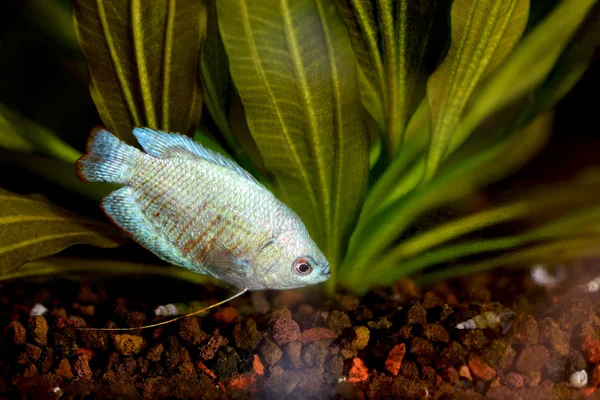
This fish species is a great choice to keep your angelfish company. Dwarf gourami is native to Southeast Asia in water bodies with the same parameters as angelfish prefers.
However, it would be ideal to create enough hiding spaces so that they can conceal themselves whenever they feel threatened.
Also, do not keep more than one male in the tank at a time. A group of females is okay, but if you have more than one, they will fight each other until they become stressed and die.
Platies
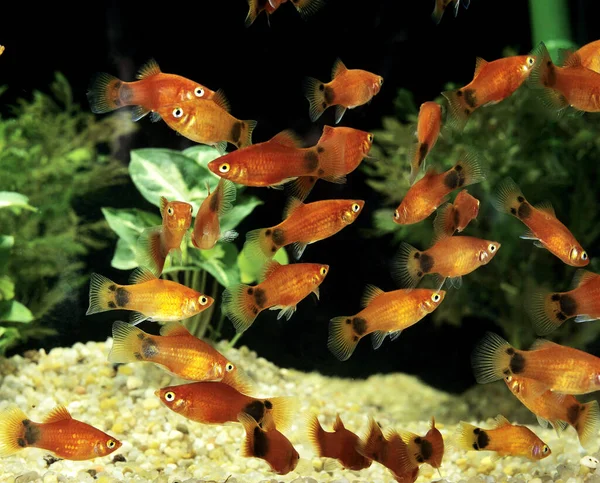
This is another great choice. But they multiply like crazy. If you choose them, it would be ideal to keep a few population control tips in mind to prevent overcrowding.
They have similar water requirements. They are also all omnivores and are all about the same size. That means you are not feeding different food options or paying extra attention to keep the water temperate at a favorable balance between two extremes as you would have done if you were cohabiting a cold-water fish with your tropical angelfish.
Other tropical freshwater fish that make a good tank mate for angelfish include zebra loaches, mollies, Boesemani rainbow fish, etc.
Other Freshwater Fish (Cold Water Fish) As Tank Mates for Goldfish
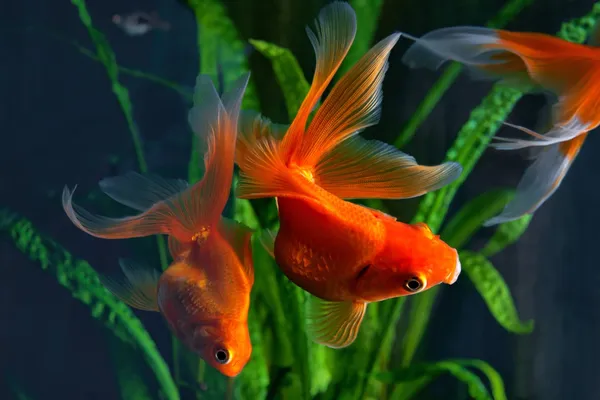
Goldfish are peaceful and easygoing fish. They do not get aggressive and are usually get along in a community tank. Choosing a good tankmate for your goldfish will greatly depend on its temperament, whether it is a cold-water fish, and how active it is in the tank (so that it does not constitute a nuisance to your goldfish).
Tankmates that pair well with goldfish in terms of low-temperature tolerance, activity level, and size include:
Shrimp (Cherry, Not Brine Shrimp)
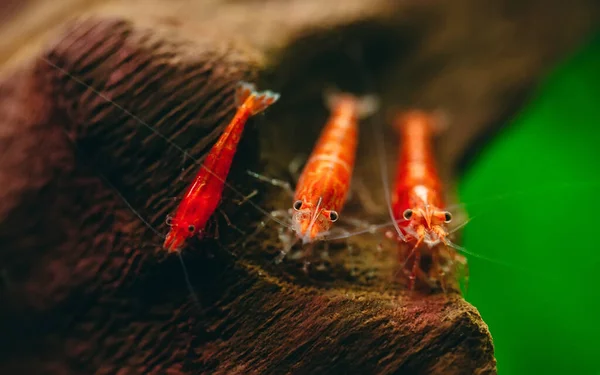
This is a great cold fish companion for your goldfish. But they can become snacks for bigger cold fish real quick. The trick is to provide a lot of hides for them.
They differ from brine shrimp in that they are bigger and red, while adult brine shrimp are gray and smaller.
Other great companions are Zebra danio, rubber lip pleco, white cloud mountain winnow, etc. Note that these tank mates are compatible on the basis of activity level, size, and tolerance for low temperatures.
You may have to learn other tricks to make the community living well-planned. This will include fixing hiding places for the shrimps and others in the community aquarium.
Other ideal tank mates that pair well with goldfish include Bristlenose plecos, Rubbernose plecos, Brochis multiradiatus, Haplo catfish, etc.
Bottom Line
Angelfish are naturally aggressive fish with impressive swimming agility and a remarkably aggressive nature. This is in sharp contrast with your goldfish, which are peaceful, slow, and beautiful fish. Putting them together is not a wise idea. Even though the angelfish do not eat the goldfish, it is highly unlikely that it will not injure the goldfish when they compete for territory food.
To be on the safer side, it would be ideal to go for a tank mate that is compatible in all respects; tropical freshwater fish for angelfish and coldwater fish for goldfish.
Another way out is keeping one species in a separate tank.
Related Reading:
- What Are Good Rainbow Fish Tank Mates?
- Are Glofish and Angelfish Good Tank Mates?
- Are Goldfish and Guppies Good Tank Mates?

